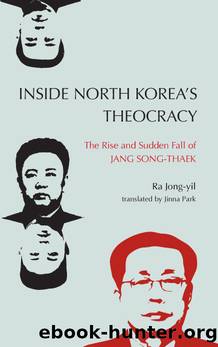Inside North Korea's Theocracy by Ra Jong-Yil

Author:Ra Jong-Yil [Jong-Yil, Ra]
Language: eng
Format: epub
ISBN: 9781438473727
Google: VCHXvAEACAAJ
Goodreads: 43505723
Publisher: State University of New York Press
Published: 2019-01-15T10:11:46+00:00
7
Sunshine, Shade, and Shadows
Sunshine is more threatening than artillery.
âKim Jong-il
After having become supreme leader in his mid-fifties, Kim Jong-il soon reached sixty. His rule had been a continuation of the hardship that preceded it. However, finally there came a way for Kim Jong-il to overcome his situation.
For the first time in fifty years, the main opposition party won a presidential election in the South, bringing a new phase of inter-Korean relations. This was at once a huge crisis and also a great opportunity. The main proponent of the so-called Sunshine Policy, Kim Dae-jung, was president in the South! Kim Jong-il knew perfectly well what a threat the Sunshine Policy could be to his regime, and now that the lifelong opposition had become the actual leader of South Korea, Sunshine was sure to become its foreign policy orientation. In the name of reconciliation, exchanges, cooperation, and ultimately reunification, he would try to break down the North.
However, Kim Jong-il was adept at using the odds to his advantage. He crafted a basic strategy that would be fleshed out by Song Ho-kyong and Ri Jong-hyok. Kim Dae-jung emphasized the need for inter-Korean reconciliation and cooperation in a public speech in Berlin, then followed it up by proposing an inter-Korean Summit during the third year of his presidential term. Kim Jong-il was ready to respond.
One of the peculiarities of inter-Korean relations is that they only move forward when both sides calculate (or miscalculate) that it is favorable to them for there to be a functioning bilateral relationship. For example, what made the first inter-Korean Summit of June 2000 possible was essentially Kim Jong-ilâs creative thinking.
However, just because both North and South Korea surmised that renewed North-South ties to be to their own advantage, the so-called Sunshine Policy, or the reality that was based on it, should not be regarded only with cynicism. In the world of politics, motive doesnât matter. You can start out with bad intentions but still achieve good results, and bring about catastrophe despite having the best of intentions.
Kim Dae-jung may have believed that the Sunshine Policy would bring about change in North Korea, and in the long run lead to the two Koreas realizing reunification, yet he did not set âachieving immediate resultsâ as his goal. He never imagined that reunification would be actualized suddenly and, even if that did happen, he did not think that it would be advantageous for the South. He saw a lesson in the case of Germany, which suffered economic difficulties after reunification. The design of his policy was that after a long period of inter-Korean exchanges and cooperation, and when the North Korean economy and other aspects of North Korean society had reached a certain level of development, a relatively low-risk reunification would be realized. That would be the final stage. In contrast, Kim Jong-ilâs design was much more complicated: a mixture of short-run economic interests and mid- to long-term military and political ones.
Around this time, Jang Song-thaek was working both construction projects in
Download
This site does not store any files on its server. We only index and link to content provided by other sites. Please contact the content providers to delete copyright contents if any and email us, we'll remove relevant links or contents immediately.
| Central Asia | Southeast Asia |
| China | Hong Kong |
| India | Japan |
| Korea | Pakistan |
| Philippines | Russia |
The Sympathizer by Viet Thanh Nguyen(4090)
The Rape of Nanking by Iris Chang(4019)
World without end by Ken Follett(3339)
Ants Among Elephants by Sujatha Gidla(3278)
Blood and Sand by Alex Von Tunzelmann(3055)
Japanese Design by Patricia J. Graham(2996)
City of Djinns: a year in Delhi by William Dalrymple(2430)
Foreign Devils on the Silk Road: The Search for the Lost Treasures of Central Asia by Peter Hopkirk(2385)
Inglorious Empire by Shashi Tharoor(2344)
The Queen of Nothing by Holly Black(2306)
In Order to Live: A North Korean Girl's Journey to Freedom by Yeonmi Park(2301)
India's Ancient Past by R.S. Sharma(2292)
Tokyo by Rob Goss(2286)
India's biggest cover-up by Dhar Anuj(2240)
Tokyo Geek's Guide: Manga, Anime, Gaming, Cosplay, Toys, Idols & More - The Ultimate Guide to Japan's Otaku Culture by Simone Gianni(2234)
The Great Game: On Secret Service in High Asia by Peter Hopkirk(2227)
Goodbye Madame Butterfly(2161)
Batik by Rudolf Smend(2005)
Living Silence in Burma by Christina Fink(1975)
